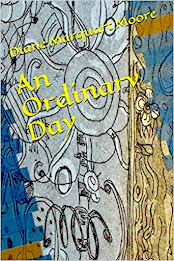Until I reached pre-teen age, my mother read to three of her children nightly from books she somehow managed to buy at Claitor’s Bookstore during WWII, a period when rationing affected the purchase of luxuries like children’s books. In our collection of children’s books from which she read, Grimm's Fairy Tales became a favored volume that included the classic folk tales of Cinderella, Rapunzel, Hansel and Gretel, Goldilocks, Little Red Riding Hood and other interesting tales that fascinated and sometimes terrified me. I attribute a lifetime love of literature to these nightly readings that delighted my mother as much as it did us. I’ve always enjoyed myths, folktales, mystical poetry and, as Charles Simic says, I believe that “…poems and paintings reassemble reality in new and unpredictably pleasing ways…are a collaboration of dream and intellect…”
Pinyon Publishing’s newest collection of poetry and art, How Still the Riddle, contains many references to myths and fairy tales, showcasing the talents of Francine Tolf, a poet who lives and works in Minneapolis and her deceased sister, Gale Tolf. Gale’s magical illustrations might have appeared within the pages of a volume like Grimm’s Fairy Tales and complement the lyrics of an inspired poet.
In the preface, the poet explains that How Still the Riddle features rhyming poems, which would have pleased her mother who “loved rhythm and sound and musicality,” and which she tried to instill in the poems of this volume. The ink and watercolor drawings by her late sister, Gale, were inspired by myth, legend, and fairytale, and are a meet companion to the rhyming poems. The artist considered Shakespeare “one of her best friends. He knew more about psychology than Freud and had a sense of humor to boot!” Her drawings often reflect her appreciation for the place of humor in memorable art.
I was drawn to nature poems in the beginning of the book; e.g., “Summer Gold” where “Luxuriant and lush, late summer/mornings melt like easy gold/to full ripe afternoons, so humming-/rich a heart can barely hold/such heavy wealth./I tell myself /to savor slow the molten skies/and laden trees and dragonflies—/but never do…” And I turned a few pages to find the drawing of a magic man who appears in “Moon,” and plucks the moon from a diamond sky, then “descends into a mountain cave,/hammered it till paper thin/with magic anvil luminous—/and then he hung it back again.” Readers will discover that many of the poems and drawings appeal to children, as well as adults and that they create the same kind of mystery indicative of the Grimm tales.
Poems like “The Desert Father” who leaves home and his comforts to fast and pray” border on morality tales, but redeem themselves by being amusing. The pleased expression on the face of the desert father who has escaped “worthless pleasure sold and bought/by desperate people craving to be whole…” becomes irony when the good father “stumbles on [his own] cunning sin of pride.”
I was intrigued by a poem with no accompanying drawing entitled “The Island of Discussion” bearing an explanatory note that this is an island in Scotland where, in the past, those with arguments traveled to sort out their problems. “They say time on this mossy-green island/heals grudges and mends cruel wounds./It might be the meadows, it might be the mist,/but sworn enemies leave its shore friends.” Francine invites readers to sail there and “unpack ancient grievances while sipping good whiskey and sweet honey cake under fir trees in lake-scented air” —an idyllic idea that takes place on an idyllic island and would that readers could make such a voyage to resolve contemporary world problems!
Poets will appreciate Francine Tolf’s tribute to poetry in “Sing Me A Poem” in which she issues the invitation to “unriddle the riddles and after you’ve mended/the tattered illusions and patches and shreds,/weave me a tapestry braided and blended/ and woven from poetry’s magical threads.” The poem is accompanied by a drawing of a wizard singing a poem to a woman holding a hand to her forehead while trying to untangle enigmas. Unexpected images and a rhyming poem with emotional color will appeal largely to the adult reader, but young readers might enjoy the illustration in this tribute as much as poetry-loving adults will appreciate the contents.
Moonflowers, wild beasts, snakes with fangs extended, fairy queens, goblins — creatures from old mythologies and cultures rise from the unconscious of poet and artist in How Still the Riddle, and, as Simic says, “make poems and paintings that reassemble reality in new and unpredictably pleasing ways.”
Francine Tolf’s work has appeared in Southern Humanities Review, Poetry East, Contrary Magazine, Rattle, and Water-Stone Review. She has received grants from the Minnesota State Arts Board and the Elizabeth George and Barbara Deming Foundations. Gale Tolf (now deceased) was an award-winning artist, writer, and teacher with a Masters degree in Gifted Education. Her art was exhibited in Mandala Gallery, Pacific Grove, CA; Carl Cherry Foundation, Carmel, CA; Northeastern Illinois University; the Pacific Grove Museum; Monterey Public Library; and many other venues.
How Still the Riddle is another handsome volume produced by Pinyon Publishing, a premier publisher of art and poetry with offices based in a log cabin on the Uncompahgre Plateau near Montrose, Colorado. Order from Pinyon Publishing, 23847 V66 Trail, Montrose, CO 81403.





















